by Jeremiah Watt
Flipping through travel planners and vacation ads, southeast Idaho sounds much like the glorious west of old. A wild untarnished space, home to elk, moose, deer, and many other species of wildlife, with hundreds of miles of rivers and creeks, all bursting with wild native trout. It is. Or at least was.
Currently, it’s home to 17 Superfund sites, thanks to phosphate mining giants Simplot, Agrium, Monsanto and others. The phosphate here is primarily used as fertilizer and the herbicide RoundUp. 16,987 acres have been mined with an additional 7,340 acres slated for development. In addition 15,000 acres have been leased and 50,000 acres are identified as containing economically viable phosphate reserves. In total 2,500 square miles – an area larger than Rhode Island – have the potential to be permanently scarred or destroyed from the effects of phosphate mining. Ninety-five percent of this land belongs to you and I.
In addition to the visual scarring and permanent destruction of entire habitats the environmental degradation due to selenium poisoning (a direct result of current phosphate mining technology) is stark. More than 600 head of livestock have died, 160 miles of streams are poisoned and Yellowstone cutthroat trout populations are declining in impacted streams.
The Greater Yellowstone Coalition is working to protect southeast Idaho’s waters, wildlife, and wildlands. Highest on their list of streams to protect is the Blackfoot in the heart of southeast Idaho’s mining district. It and its ecosystem are facing immediate peril with the current onslaught of phosphate mining and environmental degradation.
The photos below provide a sense of the impacts to this area.
Remains of a sheep that died from selenium poisoning in the phosphate patch in southeast Idaho.
With an engine at each wheel, these massive trucks are moving earth 24 hours a day.
Image from Dry Valley Mine, a phosphate mine in SE Idaho and contributor to the Superfund sites and selenium poisoning in the area.
The phosphate giant Monsanto in SE Idaho.
The Blackfoot River Wildlife Managment Area, SE Idaho.
The Blackfoot River Wildlife Managment Area, SE Idaho.
Sheep graze in the shadow of phosphate scars in SE Idaho.
Basque sheepherders moving sheep along the Blackfoot River, SE Idaho.
Smoke from Monsanto’s phosphate processing plant mixes with the clouds above fields outside Soda Springs in SE Idaho.
A big mule in velvet just off the road in the Husky 1 lease area. This habitat will be completely removed and destined for Superfund status once mining begins.
Freshly bulldozed roads for exploratory drilling in the Husky 1 area of SE Idaho.
The future lies in the distance. The foreground is slated for mining within the next five years.
Recent death in the phosphate patch in SE Idaho.
Smoky Canyon Mine over the ridge in Afton, WY.
A bulldozer and the remnants of an ecosystem.
The water and its fish are hazardous to your health.
Tim Woodard takes a stance in Crow Creek, Idaho. What’s yours?
North Maybe Superfund site, one of the 17 and growing superfund sites in SE Idaho’s phosphate patch.
The following links offer further insight and information:
The Cleanest Line – excellent discussion worth following
Interactive Map of Phosphate Mining in Greater Yellowstone Ecosystem
Huffington Post on birth defects associated with RoundUp
New York Times on setbacks in framing due to RoundUp
Jeremiah Watt is a professional photographer in Salt Lake City. See more of his work here. He is helping to sponsor the Wild and Scenic Film Festival at the University of Utah on November 15.





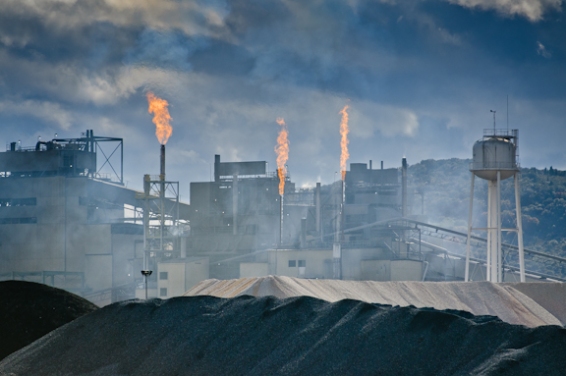

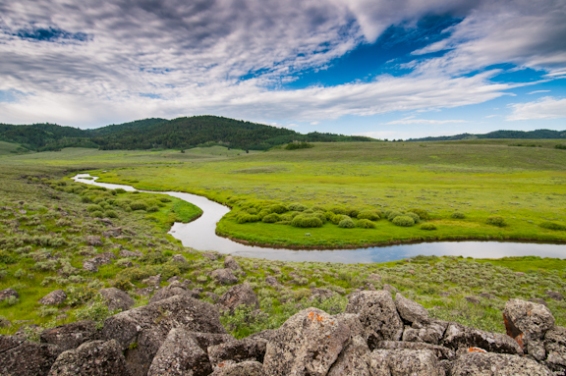
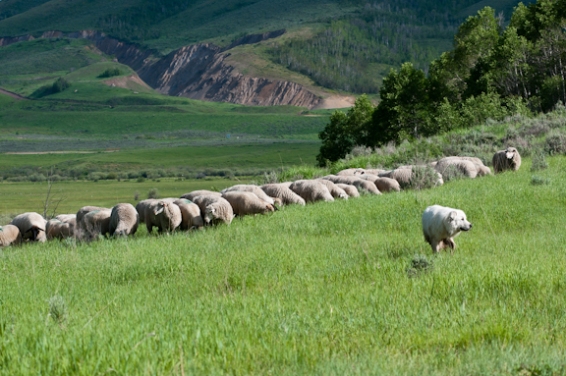
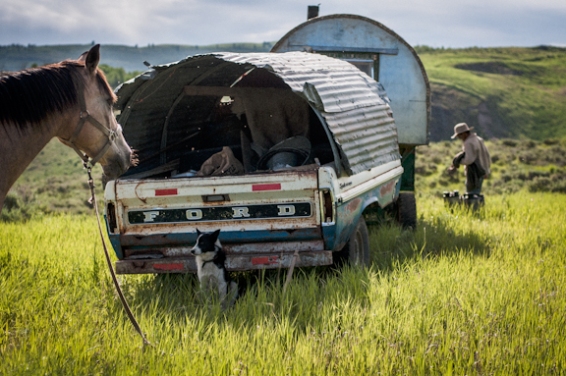



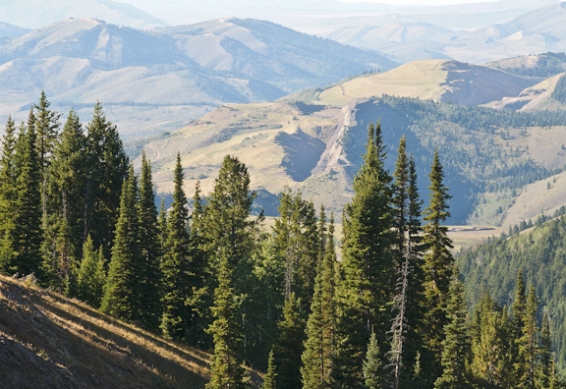
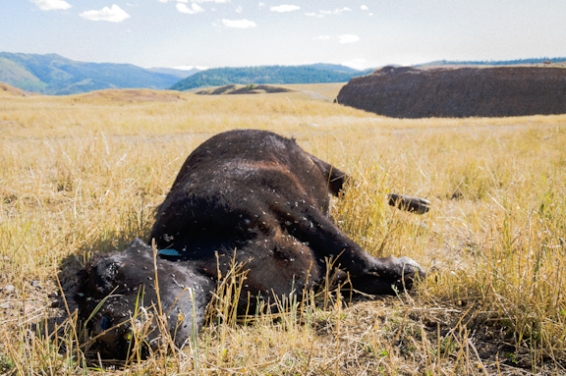





Which camera have you used to take those photos?
These were taken on a Nikon D300S (I believe, I am not the photographer!)
Wonderful images!! Congrats on being Freshly Pressed!!
Thank you!
Evil has a name: Monsanto.
It’s not just Monsanto, some other corporations are involved, too. But yes, Monsanto is very powerful in this.
Yes, I agree. There are many cohorts, but they are the poster child for nefarious human activities, like poisoning our food supply and performing draconian procedures to enforce their patenting of life. They have a wide, frightening reach into the basic needs of humanity.
Fascinating. Great pictures. Congrats on being FPd
Thanks!
On the I-86, as you approach Pocatello from the west, is a sign warning drivers of low visibility from the fertilizer plant there. I have come through there before when you can’t even see the highway in front of you. Thanks for the great story.
Thank you. It’s interesting in what ways people are willing to recognize the problem and in what ways they’re not.
I live in Pocatello, please show me where this sign is.
I don’t know about evil – but shortsighted and counterproductive seem appropriate. Phosphate extraction has been a problem elsewhere too. Nauru suffered considerable environmental damage too, and its economy hasn’t really recovered from the deposits running out either (http://en.wikipedia.org/wiki/Nauru).
We have to make the environment-as-it-is worth more to corporations than the stuff in the ground.
I know what my stance is.
Interesting – I didn’t know about Nauru’s situation. I agree that “shortsighted” is probably a good descriptor. This is about making profit now and worrying about the future only when it comes.
What’s worse, perhaps, is that it is about making a profit for a very tiny minority at the expense of everybody. Given that these resources are finite, it seems strange to me that the prices do not seem to reflect the fact that they will no longer be available at some future point.
Markets, like people, are prone to massive temporal discounting (http://en.wikipedia.org/wiki/Temporal_discounting); not a good thing.
Agreed, completely.
Pingback: Southeast Idaho’s Phosphate Legacy | myapothecium·
Reblogged this on prairie muffin manifesto and commented:
Monsanto is a leader in industrial agriculture. Here is another one of their projects that is destroying precious ecosystems by the minute.
Great…
http://soniji.wordpress.com/
Thank you!
Impressive.
http://alfjeremy.wordpress.com/
http://alfpedia.wordpress.com/
http://letscriticize.wordpress.com/
Thanks!
Wow what awesome digital pictures. Do you have a favorite?
Thank you! I think the dead cow is the most startling, and beautiful in a tragic way.
Very interesting! I went to a very eco-sustainable school here in New York, but I haven’t heard the point of view from other states. Great pictures!
Thank you. What school did you go to?
Paul Smith’s college
It’s always fun to blame the fat cats for stuff like this and they do deserve part of the blame. But Roundup is used to grow corn which is used to make ethanol which is used to fill mandates and demand created by subsidies which are the result of people demanding “clean energy”.
There is no such thing as clean energy.
I agree – it is a much more complex and challenging issue than many people often realize.
Do you have any links to take action?
The Greater Yellowstone Coalition is probably the leader in this struggle. Here’s their info on the topic: http://greateryellowstone.org/issues/lands/Feature.php?id=287
Great post. It’s just inconceivable that EIAs were done for these projects and they were greenlighted anyway. Well, conceivable but deeply, deeply distressing. As if you needed more, here’s a piece on Roundup. http://www.thegrocer.co.uk/topics/technology-and-supply-chain/monsanto-weedkiller-and-gm-maize-in-shocking-cancer-study/232603.article
It’s amazing how often Monsanto’s name crops up in direct relation to a shockingly wide range of health, environmental and agricultural problems. Again, thanks for this post.
Thank you. Most chemicals that people put on their yards or crops can cause huge problems. More effort needs to be put into spreading awareness about and improving alternatives.
It’s good to know someone cares more about protecting the irreplaceable than so called job creation. Keep up the good work, as always pictures say a thousand words. Phosphate is the last thing the world needs right now. Over here in the UK we have massive problems with it getting into water bodies like rivers even after the utility companies have cleaned the water from our homes. In summary, I wish we had as much wilderness as you lot!
Thank you. Unfortunately I think it is often forgotten/hidden that sustainable practices can actually create jobs, too. Job creation has become a buzz phrase in some ways, while any other concerns are ignored. The UK has some truly beautiful wilderness, as well! Sometimes having more land means more problems, contention, and destruction, like here.
Reblogged this on vacation and commented:
Add your thoughts here… (optional)
What can we do to help sustain these areas? Write congressman? Send letters? Great Post!
The Greater Yellowstone Coalition is leading the fight: http://greateryellowstone.org/issues/lands/Feature.php?id=287 They have suggestions for getting involved, I would also suggest maybe contacting them. Thanks for the interest!
Reblogged this on Eremophila's Musings and commented:
Once again, my old enemy Monsanto involved in deadly practices.
Your images capture the spirit of Idaho both in the stunning landscape and in the devastation the mining is inflicting. I am particularly interested in hidden impacts on the environment and our health, so will find your blog stimulating regarding information and inspirational with the imagery.
I am currently artist-in-residence at University of Central Lancashire in UK.
I’m writing a book on Monsanto. My son and I are running across America to to promote GMO awareness. Do you own the monsanto.jpg image? I’d like permission to use it in my Monsanto book. Please let me know or point me in the right direction. Thanks!
Hi, thank you for your interest. I’m the maintainer of the blog and do not own the image. It was taken and is owned by Jeremiah Watt. Find his contact information here: http://www.jeremiahwattphotography.com/#mi=1&pt=0&pi=3&p=-1&a=0&at=0 Thank you.
I work in these phosphate mines in Idaho. My dad has worked there for 20 years. These are good companies who do and spend more money than you’ll ever understand on reclaim and the environment. I was discusted as I read your article, first off because all of your “facts” are completely biased twisted and some are flat out lies. Without Monsanto and Agrium (who my company is the mining contractor for) are feeding you. Next time you eat your tofu thank the southeast idaho mining district. I would strongly suggest that all of you reading this, before you listen to the liberal agenda, you go and see it for yourself. Most of these photos are photoshopped, ex: for one the picture of the dry valley mine (a mine I personally worked in the reclaim project on) would never look like that with the dust and pollution MSHA would shut us down so quick, there wouldn’t be time to take a picture. All the “pollution” coming out of the plants, is only steam… So this website is completely off base.